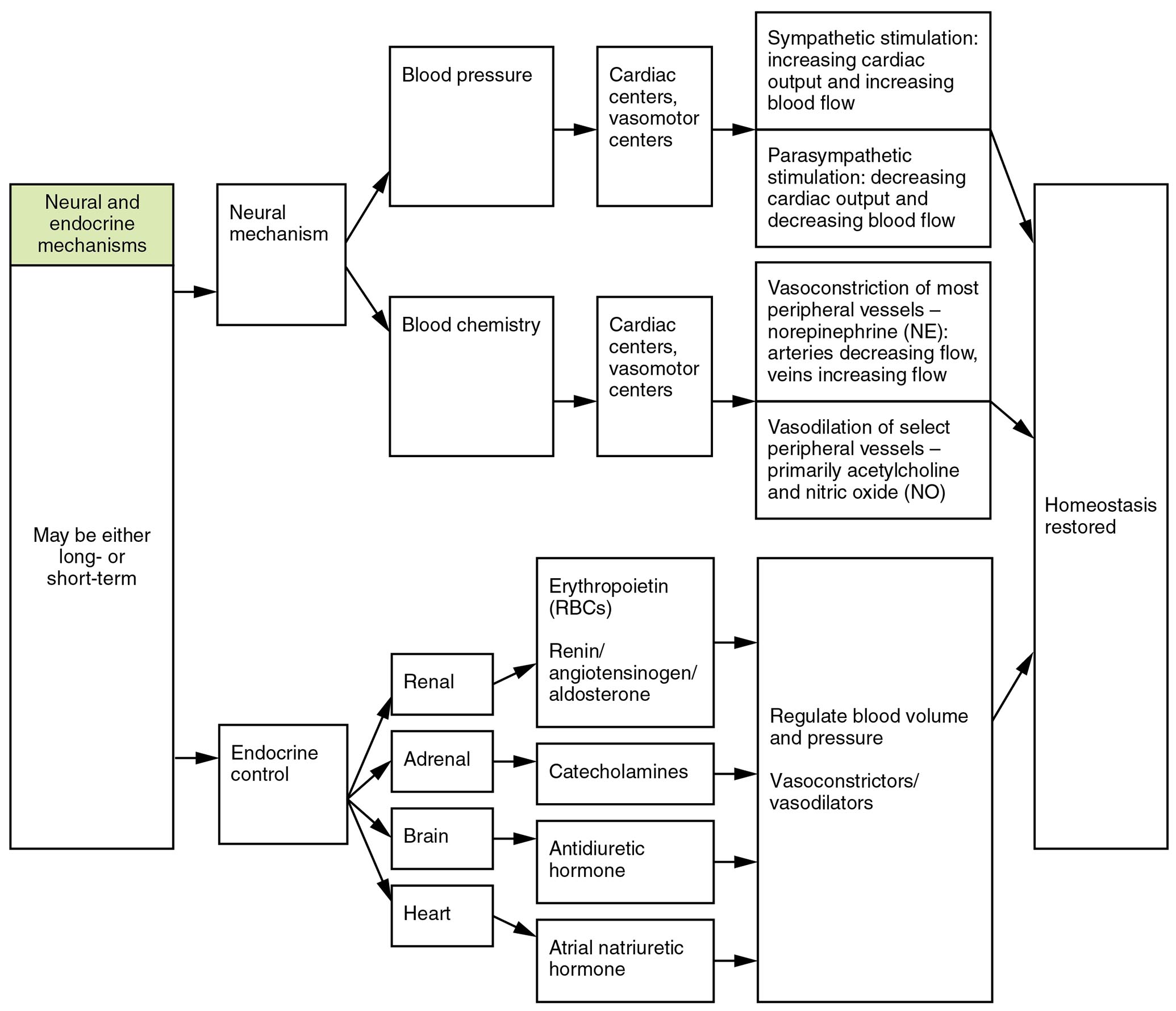The human body relies on intricate neural and endocrine mechanisms to maintain homeostasis, ensuring a stable internal environment despite external changes. This diagram highlights how the nervous system and hormonal signals collaborate to regulate vital functions such as blood pressure, temperature, and metabolism, providing a clear insight into these physiological processes.

Hypothalamus Hypothalamus serves as the central control hub, integrating neural and endocrine signals to maintain homeostasis. It regulates functions like hunger, thirst, and temperature by releasing hormones that stimulate the pituitary gland.
Pituitary gland Pituitary gland, often called the master gland, releases hormones under hypothalamic control to influence other endocrine organs. It produces growth hormone, thyroid-stimulating hormone (TSH), and adrenocorticotropic hormone (ACTH) to regulate metabolism and stress responses.
Adrenal glands Adrenal glands produce adrenaline and cortisol in response to neural and hormonal cues, aiding in the “fight or flight” response and stress management. These glands also regulate blood pressure and electrolyte balance through aldosterone secretion.
Thyroid gland Thyroid gland releases hormones like T3 and T4, stimulated by TSH, to control metabolic rate and energy production. It plays a key role in maintaining body temperature and supporting growth and development.
Pancreas Pancreas secretes insulin and glucagon to regulate blood glucose levels, responding to both neural input and blood sugar changes. This dual hormonal action ensures energy availability and prevents hyperglycemia or hypoglycemia.
Sympathetic nervous system Sympathetic nervous system activates during stress, increasing heart rate and dilating airways via the release of norepinephrine. It works alongside endocrine signals to prepare the body for immediate action.
Parasympathetic nervous system Parasympathetic nervous system promotes rest and digestion, slowing heart rate and enhancing gastrointestinal activity through acetylcholine release. It balances the sympathetic system to maintain equilibrium.
Baroreceptors Baroreceptors are pressure-sensitive receptors in blood vessels that detect changes in blood pressure and send signals to the brain. They trigger reflex adjustments via the autonomic nervous system to stabilize circulation.
Chemoreceptors Chemoreceptors monitor blood pH, carbon dioxide, and oxygen levels, located in the carotid bodies and aorta. They initiate corrective responses through neural and hormonal pathways to maintain respiratory and metabolic balance.
Overview of Neural and Endocrine Mechanisms
This diagram illustrates the coordinated efforts of neural and endocrine systems in preserving homeostasis. Each component contributes to a dynamic balance that supports life’s essential processes.
- Hypothalamus acts as the command center, linking brain activity with hormonal output.
- Pituitary gland amplifies these signals, directing other glands’ functions.
- Adrenal glands, thyroid gland, and pancreas execute specific hormonal roles.
- Sympathetic nervous system and parasympathetic nervous system provide rapid neural regulation.
- Baroreceptors and chemoreceptors offer sensory feedback to fine-tune responses.
Neural Mechanisms in Homeostasis
The nervous system provides swift adjustments to maintain internal stability. Its rapid responses are crucial for immediate physiological needs.
- Sympathetic nervous system increases blood pressure during stress by constricting vessels.
- Parasympathetic nervous system lowers heart rate post-stress, aiding recovery.
- Baroreceptors in the carotid sinus detect pressure drops, triggering compensatory tachycardia.
- Chemoreceptors respond to hypoxia, stimulating breathing to restore oxygen levels.
- These systems work in tandem to regulate circulation and respiration.
Role of the Autonomic Nervous System
The sympathetic nervous system and parasympathetic nervous system form the autonomic framework. Their opposing actions ensure a balanced response to environmental changes.
- Sympathetic nervous system activates adrenal medulla for adrenaline release.
- Parasympathetic nervous system enhances insulin secretion from the pancreas during rest.
- This balance prevents overactivation, maintaining blood pressure and glucose levels.
- Neural signals from baroreceptors modulate these effects in real-time.
- The system adapts to stressors like exercise or emotional strain.
Endocrine Mechanisms in Homeostasis
Hormonal regulation offers a slower, sustained approach to maintaining balance. These mechanisms address long-term physiological demands.
- Hypothalamus releases thyrotropin-releasing hormone (TRH) to stimulate the thyroid gland.
- Pituitary gland secretes TSH, driving T3 and T4 production for metabolism.
- Adrenal glands release cortisol to manage inflammation and stress.
- Pancreas adjusts insulin and glucagon based on glucose levels.
- Hormones from these glands stabilize fluid, energy, and temperature homeostasis.
Sensory Feedback via Receptors
Baroreceptors and chemoreceptors provide critical sensory input for homeostasis. Their feedback loops enhance regulatory precision.
- Baroreceptors signal the hypothalamus to adjust heart rate via the autonomic system.
- Chemoreceptors detect acidosis, prompting adrenal glands to release adrenaline.
- This feedback helps maintain blood pressure within normal limits.
- Receptors also influence pituitary gland hormone release during pH imbalances.
- Their role is vital in preventing circulatory or respiratory failure.
Clinical Relevance of Homeostasis Mechanisms
Understanding these systems aids in diagnosing and treating imbalances. Their dysfunction can lead to various health challenges.
- Overactive sympathetic nervous system may cause hypertension or anxiety.
- Thyroid gland underactivity leads to hypothyroidism, slowing metabolism.
- Adrenal glands insufficiency, as in Addison’s disease, disrupts stress response.
- Pancreas dysfunction results in diabetes due to insulin imbalance.
- Monitoring baroreceptors and chemoreceptors helps manage shock or respiratory issues.
In conclusion, the neural and endocrine mechanism and homeostasis diagram showcases the seamless integration of hypothalamus, pituitary gland, adrenal glands, thyroid gland, pancreas, sympathetic nervous system, parasympathetic nervous system, baroreceptors, and chemoreceptors in maintaining equilibrium. This collaborative effort ensures the body adapts to internal and external changes, supporting overall health and resilience. A deeper grasp of these processes enhances the ability to address physiological disruptions effectively.

